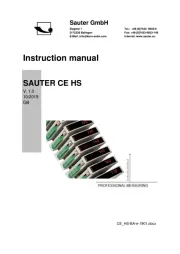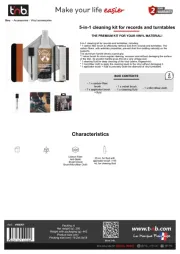Sauter HMM Handleiding
Bekijk gratis de handleiding van Sauter HMM (8 pagina’s), behorend tot de categorie Niet gecategoriseerd. Deze gids werd als nuttig beoordeeld door 85 mensen en kreeg gemiddeld 4.1 sterren uit 43 reviews. Heb je een vraag over Sauter HMM of wil je andere gebruikers van dit product iets vragen? Stel een vraag
Pagina 1/8

Sauter GmbH
Tieringerstr. 11-15
D-72336 Balingen
E-Mail: info@sauter.eu
Tel: +49-[0]7433- 9976-174
Fax: +49-[0]7433-9976-285
Internet: www. sauter.eu
Instruction Manual
HMM
HMM-BA-e-1111 1
MOBILE LEEB HARDNESS TESTER
Model: HMM
Table of contents
Caution
1. Summarize
1.1 Measuring Principle Scope
1.2 Hardness Value „L“
1.3 Main Features
1.4 Application Range
1.5 Technical Information
1.5.1 Display Unit
1.5.2 Impact Unit D
1.6 Overview Display Unit
1.7 Impact Device Assembling
2. Checking Supplied Accessories
3. Quick Start Guide
3.1 Cable Connection
3.2 Calibration
4. Operation Instructions
4.1 Display Unit
4.1.1 Keys
4.1.2 Measurement Mode
4.1.3 Setup
4.1.3.1 Material Group
4.1.3.2 Impact Direction
4.1.3.3 Scale
4.1.3.4 Browse
4.1.3.5 Adjusting Clock and Calendar
4.1.3.6 Calibration
4.2 The Format of Memory Data
4.3 Backlight
4.4 System Reset
4.5 Automatic Shutdown
5. Printing Data
5.1 Printer Link
5.2 Test Report Format
6. Hardness Test
6.1 Test Preparation
6.2 Sample Preparation
6.3 Test Steps
7. Troubles and Solutions
8. Maintenance and Service
8.1 Impact device Maintenance
8.2 Storage of Report
8.3 Normal Maintenance Procedures
APPENDIX 1 Daily Checking
APPENDIX 2 Factors affecting the Accuracy
APPENDIX 3 Measuring and Conversion Range
APPENDIX 4 Material Code
9. Declaration of Conformity
Caution
Please read this carefully first:
1. Only the special battery offered by our Company may be
used in the main body of the hardness tester. Improper
batteries might cause damages to the instrument, battery
leakage, even fire or explosion.
2. Any components of the instrument may not get
submerged in water or get exposed to rain, which could
cause a battery explosion and damage the main body.
3. Electrical shocks have to be avoided; the cabinet may
not be opened.
4. If the instrument hasn’t been used for a longer period, it
has to be stored in a cool and dry place.
1. Summarize
1.1 Measuring Principle Scope
The measuring principle of HMO Hardness Tester is
physically a rather simple dynamic hardness test:
An impact body with a hard metal test tip is propelled by
spring force against the surface of the test piece. Surface
deformation takes place when the impact body hits the test
surface, which results in a loss of kinetic energy. This
energy loss is calculated by velocity measurements when
the impact body is at a precise distance from the surface
for both, the impact phase and the rebound phase, of the
test. The permanent magnet in the impact body generates
an induction voltage in the single coil of the impact device.
The voltage of the signal is proportional to the velocity of
the impact body. A signal processing by the electronics
provides the hardness reading for display and storage.
Simply said, harder materials produce higher rebound
velocities than less harder ones (higher L- value).
HMM Hardness Tester provides a direct hardness
measurement within any particular material group (i.e.
steel, aluminium etc.). It can be used as a final test result
without conversion. However, there are established
conversions to other hardness scales in this Hardness
Tester as a comfort for our customers. These conversions
to other scales (HRC, HRB, HB, HV, HSD etc.) are
programmed into the electronics and they can be shown
directly on the display as a test result. All data is stored in
the native L scale to prevent any possible errors with
multiple conversions.

Sauter GmbH
Tieringerstr. 11-15
D-72336 Balingen
E-Mail: info@sauter.eu
Tel: +49-[0]7433- 9976-174
Fax: +49-[0]7433-9976-285
Internet: www. sauter.eu
Instruction Manual
HMM
HMM-BA-e-1111 2
1.2. The Hardness value “L”
This term was introduced 1978 into measuring technology
by Dr. Dietmar Leeb. It contains the quotient for the impact
body’s rebound and impact velocity, multiplied by 1000.
Harder materials produce higher rebound velocity than
less harder ones. With reference to a particular material
group (i.e. steel, aluminium etc.), the L value represents a
direct hardness measurement and is used as such.
Comparison curves with other standard statistic hardness
values have been established (Brinell, Vickers, Rockwell
C, B) for the most prevalent materials, enabling the
L values to be converted into the relevant values by these
procedures. With this hardness tester, such hardness
values can directly be displayed in the hardness scales
HRC, HRB, HB, HV, HSD and tensile strength (MPa).
1.3 Main features
- Highly accurate, ± 6 HL
- Automatic correction for impact direction
- Large, easy to read display with backlight
- User profiles for fast change of all settings
- Conversion to all common hardness scales
HRC, HRB, HB, HV, HSD and tensile strength
(MPa).
- Supplied by dry-cell, Ultra-low-power
- Easy calibration
- Conforms to the Standard ASTM A956-02
1.4 Application range
- Appropriate for all metals
- Ideal for production level testing
- Best suited for on- site testing of heavy, big or
already installed parts
- Handy for difficult to access or confined test
locations
- Automatic compensation for impact direction
- Excellent for material selection and acceptance
tests
- Easy to handle and accurate on curved test
surfaces (R> 10mm)
- Metal production & processing
- Automotive & transportation
- Aerospace & shipyard
- Testing services & laboratories
1.5 Technical information
1.5.1 Display unit
* HL Display range: 0 to 999 HLD
* Accuracy: ± 6 HL
* LCD: large LCD with backlight
* Resolution: 1 HL; 1 HV; 1 HB; 0,1 HRC;
0,1HRB; 1 HSD; 1 MPa
* Power: dry cell (3 x 1.5V AAA)
* Operating temperature: 0°C up to + 50°C
(32°F up to 122°F)
* Storage Temperature: -10°C up to + 60°C
(14°F up to 140°F)
* Humidity: 90 % max.
* Dimensions: 150mm x 80mm x 24mm
(5.9 x 3.1 x 0.9 inches)
* Weight: Approx. 200g (main body)
1.5.2 Impact unit D
Impact energy: 11 Nmm
Mass of the impact body: 5.5 g
Test tip diameter: 3 mm
Test tip material: tungsten carbide
Test tip hardness: ≥ 1600 HV
Impact length: 147 mm
Impact maximum diameter: 20 mm
Impact weight: 75 g
1.6 Overview Display Unit
Picture 1-1
1.7 Impact Device Assembling
1. Impact body
2. Support ring
3. Coil
4. Cable
5. Catch chuck
6. Loading tube
7. Release button
2. Checking supplied accessories
It should be checked that the following accessories are
supplied with your instrument
Picture 2-1

Sauter GmbH
Tieringerstr. 11-15
D-72336 Balingen
E-Mail: info@sauter.eu
Tel: +49-[0]7433- 9976-174
Fax: +49-[0]7433-9976-285
Internet: www. sauter.eu
Instruction Manual
HMM
HMM-BA-e-1111 3
The items are supplied with the hardness tester. The
accessories available may vary from retailer to retailer,
depending on the country or service provider.
The purchased accessories only have to be used with
Polygon-authorised devices. The use with other devices
could cause problems and any repair costs wouldn’t be
covered by warranty.
3. Quick start guide
3.1 Connection
The signal cable has to be connected to the impact device
and the display unit.
Picture 3-1
3.2 Calibration
The test block has been calibrated in accordance with the
dynamic hardness value L. The HMM Impact Hardness
Tester has to be calibrated by the test block before the first
use (APPENDIX 1)
4. Operating instructions
4.1 Display unit
4.1.1 Keys
Picture 4-1
1. “On/Off“ button: The instrument is turned on and
off by pressing and holding the button.
2. button: The button has to be Backlight
pressed to turn on and off the LCD backlight.
3. button: “Back/Print”
a) In measurement mode, the “Back/Print” button has to
be pressed to erase the measured data. At the same time,
if the mini-printer is linked with the display unit, those data
will be printed out.
b) In other mode, the button has to be “Back/Print”
pressed to complete setup and to save the parameters set.
Then it is returned to measurement mode.
4. button: browse the memory data. “Browse”
5. button: adjustment of clock and calendar “Date/Time”
6. button: This button has to be pressed to delete
current data in measurement mode or browse mode.
7. button: It has to be pressed to setup the conversion
scale in measurement mode. In Date/Time setup mode
and in calibration mode, this button has to be pressed to
decrease the flickering bit. In browse mode, button has
to be pressed to display the next data.
8. button: It has to be pressed to setup the impact
direction in measurement mode. In Date/Time setup mode
and in calibration mode, this button has to be pressed to
increase the flickering bit. In browse mode, button has
to be pressed to display the previous data.
9. button: In measurement mode, it has to be pressed
to select the material that will be impacted. In Date/Time
setup mode and in calibration mode, this button has to be
pressed to select the next bit.
4.1.2 Measurement Mode
HMM Hardness Tester has got a large LCD and an
abundance of information.
Picture 4-2
4.1.3 Setup
4.1.3.1 Material Group
In measurement mode, button has to be pressed to
select the material that will be impacted. Following material
list is shown on the back of the instrument:
2
Product specificaties
| Merk: | Sauter |
| Categorie: | Niet gecategoriseerd |
| Model: | HMM |
Heb je hulp nodig?
Als je hulp nodig hebt met Sauter HMM stel dan hieronder een vraag en andere gebruikers zullen je antwoorden
Handleiding Niet gecategoriseerd Sauter

7 Januari 2025

7 Januari 2025

7 Januari 2025

7 Januari 2025

3 Juni 2023

14 Mei 2023

10 Mei 2023

8 Mei 2023

27 April 2023

27 April 2023
Handleiding Niet gecategoriseerd
- SafeMi
- Vileda
- Binatone
- Hikoki
- Pentel
- Vantage Point
- Tempmate
- Daewoo
- Manduca
- FitterFirst
- Nicols
- Mac Tools
- Trebs
- REMKO
- Omnilux
Nieuwste handleidingen voor Niet gecategoriseerd

13 September 2025

13 September 2025

13 September 2025

13 September 2025

13 September 2025

13 September 2025

13 September 2025

13 September 2025

13 September 2025

13 September 2025